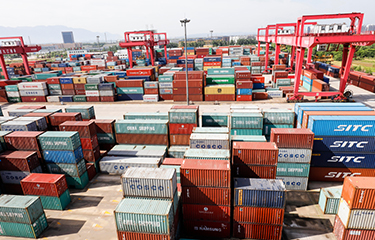A severe shortage of shipping containers is leading to rising shipping costs and difficulty moving goods, playing havoc with seafood exporters in Asia.
The shortage has been felt by all major exporters in Vietnam, Thailand, China, and India. Data from Vietnamese seafood exporters show that the shipping cost to the European Union rose between 145 percent and 276 percent in January, compared to December last year.
Shipping rates from Vietnam to major ports this month increased to USD 7,000 (EUR 5,798) per container, from USD 2,850 (EUR 2,360) per container last month. Some carriers charged as much as USD 10,550 (EUR 8,738) for a container this month, up from USD 2,800 (EUR 2,319) per container in December.
The rates for shipping to ports in the U.S. West Coast also surged to USD 4,000 (EUR 3,313) per container in January, from USD 3,500 (EUR 2,899) per container in December, while the costs for U.S. East Coast ports rose to USD 5,850 (EUR 4,845) per container from USD 4,900 (EUR 4,058) per container, according to information shared by the Vietnam Association of Seafood Exporters and Producers (VASEP) on 18 January.
The cost for a 40-foot container to the U.K. has also risen, increasing from USD 1,000 (EUR 828.2) per container to USD 8,000 (EUR 6,626) per container, or even as high as USD 10,000 (EUR 8,282) per container, in the last three months.
On 12 January, the Vietnam Maritime Administration (VMA), under the Ministry of Transport; and the Department of Import and Export, under the Ministry of Industry and Trade; held a meeting with exporters and foreign carriers to look for ways to address the issue. Exporters said at the meeting that their export capacity was seriously affected because of the rising shipping rates.
Representatives from the carriers told attendees of the meeting the COVID-19 pandemic has delayed unloading at many major ports in the world. As a result, empty containers are stuck at ports and have not been able to return to Asia to meet rising demand from exporters during year-end seasons.
The shipping companies have said the number of ships traveling through Vietnamese ports hasn't changed, but the container shortage has made it impossible for them to operate as planned. They suggested that local authorities allow them to use of thousands of abandoned containers available in many ports in Vietnam as a temporary solution.
VMA Deputy Director Hoang Hong Giang asked the shipping companies to publicly declare their freight rates and surcharges as demanded by the department in a December letter. He said authorities will study the suggestions made by the carriers.
On 15 January, the Vietnamese government said in a statement that Deputy Prime Minister Trinh Dinh Dung has directed the ministries of transport, industry, and trade to work closely with trade associations and exporters to address the situation. He also warned against any move to raise shipping costs in an illegal way and directed the authorities to punish such instances if found.
Like other companies, Minh Phu Seafood – Vietnam’s leading shrimp exporter – is facing a shortage of available containers for loading its goods. Shipping costs have soared by 300 to 500 percent, which has affected its export activities, Minh Phu CEO Le Van Quang confirmed to SeafoodSource on 19 January.
Vietnam’s Ministry of Industry and Trade said in a report to the central government that the shortage of ships and containers is likely to last until February or March, or even longer if the COVID-19 pandemic is not brought under control globally, VASEP said in separate statement on 28 December.
Many orders have been canceled in November and December, resulting in companies’ posting a lower-than-expected export performance. VASEP estimated Vietnam will earn USD 8.6 billion (EUR 7.1 billion) from seafood exports for 2020 due to increased export activities in the fourth quarter. But the association also acknowledged the target might not be achieved due to the shortage of containers and rising shipping costs. In fact, customs data showed that the actual figure is USD 8.41 billion (EUR 6.96 billion), down 1.5 percent from 2019.
VASEP said it is doing a survey to see how exporters are being affected by the container shortage, and will recommend suitable measures to the government to cope with the situation.
Thailand, another major seafood-exporting country in Southeast Asia, is facing the same container shortage problems. The pandemic has boosted demand for canned food and tuna, but the shortage of containers is making it difficult for Thai exporters to ship their cargoes, The Nation reported 16 January, citing industry experts.
Thailand’s tuna export value was estimated at THB 80 billion (USD 2.6 billion, EUR 2.2 billion) in 2020, up 3.9 percent from THB 77 billion (USD 2.5 billion, EUR 2.1 billion) in 2019, Thai Tuna Industry Association President Chanin Chalisaraphong said.
“This year we estimate that tuna exports will expand by at least 5 percent, as orders are now pouring in for delivery within the first quarter of 2021,” Chalisaraphong said.
Those numbers are expected to hold, as long as the issue with shipping containers is resolved.
“The biggest problem exporters are facing right now is inadequate supply of containers, as over a thousand containers are still stuck in the United States and Europe due to COVID-19 restrictions. Containers that came back on time are being sent to China,” Chalisaraphong said, adding that the association is asking officials in the ministries of commerce and transport to work with foreign officials to return empty containers to Thailand as early as possible.
In December last year, Thailand’s Commerce Minister Jurin Laksanawisit said his ministry will step in to assist exporters by providing a certain subsidy for import fees for empty and used containers over January-June 2021, the Bangkok Post reported 15 December.
Thailand’s demand for containers declined to some 3.5 million in 2020, from 5 million in 2019, due to the pandemic.
Shipping costs from China to the west and east coasts of the U.S., by the end of 2020, also surged 208 percent and 110 percent per 40-foot container, respectively, compared to 2019, South China Morning Post reported 11 January, citing figures provided by maritime industry and freight market information provider Baltic Exchange.
The rates from China to Northern Europe also rose more than 60 percent in December.
Vietnam’s VASEP said the shortage of containers in China began occurring earlier than in other countries. And as China has tried to rent as many empty containers as possible for its huge export needs, the shortage of containers has become more serious in Vietnam and other Asian countries.
In India, the country’s shrimp export value might fall by around 15 percent in this financial year due mainly to the shortage of containers. Cargoes at ports such as Chennai and Kochi were badly hit by the situation, Money Control reported in December.
Photo courtesy of humphery/Shutterstock







